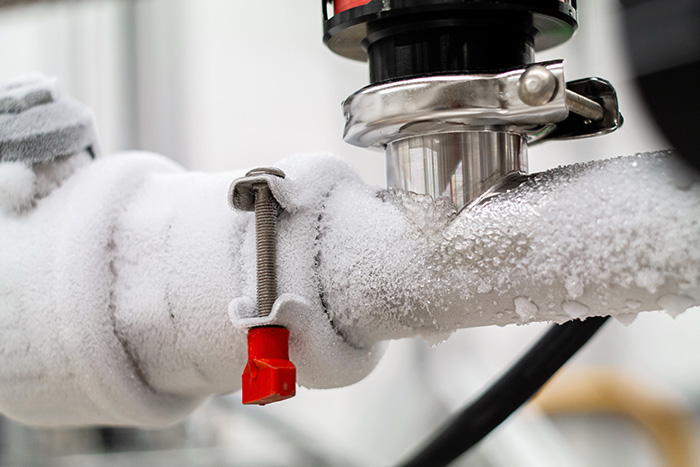Shielding Your Pipes from Cold Weather Issues: Critical Approaches
Shielding Your Pipes from Cold Weather Issues: Critical Approaches
Blog Article
The content listed below in relation to Helpful Tips to Prevent Frozen Pipes this Winter is fairly enjoyable. You should see for yourself.

Winter can ruin your plumbing, specifically by freezing pipelines. Below's just how to avoid it from occurring and what to do if it does.
Introduction
As temperatures drop, the threat of icy pipes increases, possibly bring about pricey repair services and water damage. Comprehending how to stop icy pipes is essential for homeowners in cold climates.
Recognizing Frozen Pipelines
What causes pipelines to freeze?
Pipelines freeze when revealed to temperatures listed below 32 ° F (0 ° C) for extended durations. As water inside the pipelines freezes, it expands, putting pressure on the pipeline wall surfaces and potentially triggering them to break.
Dangers and problems
Frozen pipes can bring about supply of water disturbances, building damages, and expensive fixings. Burst pipelines can flood homes and trigger extensive architectural damages.
Signs of Frozen Water Lines
Identifying icy pipes early can avoid them from breaking.
How to identify frozen pipelines
Look for reduced water flow from faucets, unusual odors or noises from pipelines, and noticeable frost on subjected pipes.
Prevention Tips
Protecting vulnerable pipes
Cover pipelines in insulation sleeves or use heat tape to shield them from freezing temperatures. Concentrate on pipelines in unheated or exterior locations of the home.
Home heating techniques
Keep interior areas properly heated up, specifically locations with pipes. Open up cupboard doors to enable cozy air to flow around pipelines under sinks.
Shielding Exterior Pipes
Yard tubes and outside taps
Separate and drain pipes yard hoses before winter season. Install frost-proof spigots or cover exterior taps with shielded caps.
What to Do If Your Pipes Freeze
Immediate actions to take
If you believe icy pipes, keep taps open up to soothe stress as the ice melts. Utilize a hairdryer or towels taken in hot water to thaw pipes gradually.
Long-Term Solutions
Structural changes
Take into consideration rerouting pipelines far from exterior wall surfaces or unheated areas. Include extra insulation to attic rooms, basements, and crawl spaces.
Upgrading insulation
Purchase high-quality insulation for pipelines, attics, and walls. Proper insulation assists keep regular temperature levels and lowers the threat of frozen pipes.
Verdict
Preventing frozen pipelines calls for aggressive steps and fast feedbacks. By understanding the causes, signs, and preventive measures, property owners can secure their pipes during cold weather.
5 Ways to Prevent Frozen Pipes
Drain Outdoor Faucets and Disconnect Hoses
First, close the shut-off valve that controls the flow of water in the pipe to your outdoor faucet. Then, head outside to disconnect and drain your hose and open the outdoor faucet to allow the water to completely drain out of the line. Turn off the faucet when done. Finally, head back to the shut-off valve and drain the remaining water inside the pipe into a bucket or container. Additionally, if you have a home irrigation system, you should consider hiring an expert to clear the system of water each year.
Insulate Pipes
One of the best and most cost-effective methods for preventing frozen water pipes is to wrap your pipes with insulation. This is especially important for areas in your home that aren’t exposed to heat, such as an attic. We suggest using foam sleeves, which can typically be found at your local hardware store.
Keep Heat Running at 65
Your pipes are located inside your walls, and the temperature there is much colder than the rest of the house. To prevent your pipes from freezing, The Insurance Information Institute suggests that you keep your home heated to at least 65 degrees, even when traveling. You may want to invest in smart devices that can keep an eye on the temperature in your home while you’re away.
Leave Water Dripping
Moving water — even a small trickle — can prevent ice from forming inside your pipes. When freezing temps are imminent, start a drip of water from all faucets that serve exposed pipes. Leaving a few faucets running will also help relieve pressure inside the pipes and help prevent a rupture if the water inside freezes.
Open Cupboard Doors
Warm your kitchen and bathroom pipes by opening cupboards and vanities. You should also leave your interior doors ajar to help warm air circulate evenly throughout your home.

As a devoted person who reads on Preventing and dealing with frozen pipes, I thought sharing that article post was a good thing. Do you know somebody else who is intrigued by Helpful Tips to Prevent Frozen Pipes this Winter? Feel free to promote it. I thank you for your readership.
Phone Report this page